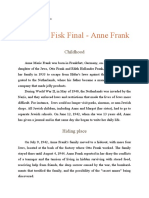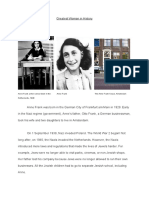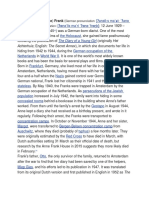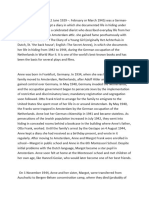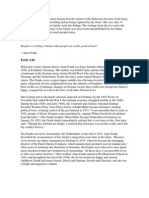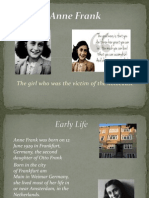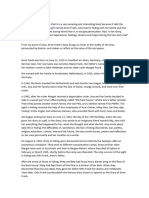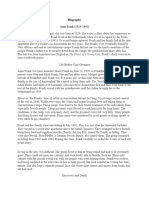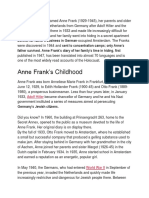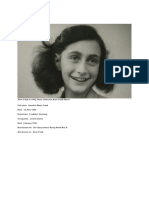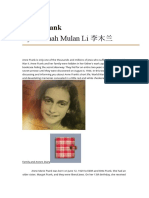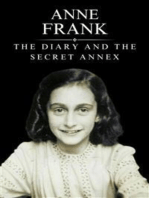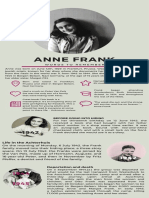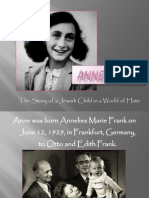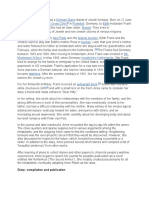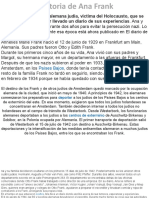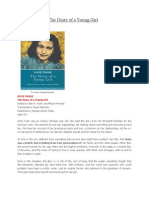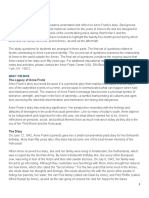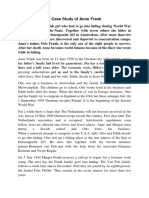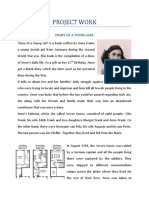0 ratings0% found this document useful (0 votes)
48 viewsFrankfurt Am Main Concentration Camp Diary The Netherlands Nazi Adolf Hitler Otto Frank Amsterdam
Frankfurt Am Main Concentration Camp Diary The Netherlands Nazi Adolf Hitler Otto Frank Amsterdam
Uploaded by
Riya PatilAnne Frank kept a diary from June 1942 to August 1944 while she and her family hid from the Nazis in an attic in Amsterdam. Her diary documents her life in hiding and her hopes for the future. In August 1944, the group was discovered and transported to concentration camps, where Anne and her sister died of typhus at Bergen-Belsen in March 1945, just weeks before it was liberated. Otto Frank was the only family member to survive. He published Anne's diary in 1947, which has since become one of the most widely read accounts of the Holocaust.
Copyright:
© All Rights Reserved
Available Formats
Download as DOCX, PDF, TXT or read online from Scribd
Frankfurt Am Main Concentration Camp Diary The Netherlands Nazi Adolf Hitler Otto Frank Amsterdam
Frankfurt Am Main Concentration Camp Diary The Netherlands Nazi Adolf Hitler Otto Frank Amsterdam
Uploaded by
Riya Patil0 ratings0% found this document useful (0 votes)
48 views5 pagesAnne Frank kept a diary from June 1942 to August 1944 while she and her family hid from the Nazis in an attic in Amsterdam. Her diary documents her life in hiding and her hopes for the future. In August 1944, the group was discovered and transported to concentration camps, where Anne and her sister died of typhus at Bergen-Belsen in March 1945, just weeks before it was liberated. Otto Frank was the only family member to survive. He published Anne's diary in 1947, which has since become one of the most widely read accounts of the Holocaust.
Original Description:
Original Title
Anne Frank
Copyright
© © All Rights Reserved
Available Formats
DOCX, PDF, TXT or read online from Scribd
Share this document
Did you find this document useful?
Is this content inappropriate?
Anne Frank kept a diary from June 1942 to August 1944 while she and her family hid from the Nazis in an attic in Amsterdam. Her diary documents her life in hiding and her hopes for the future. In August 1944, the group was discovered and transported to concentration camps, where Anne and her sister died of typhus at Bergen-Belsen in March 1945, just weeks before it was liberated. Otto Frank was the only family member to survive. He published Anne's diary in 1947, which has since become one of the most widely read accounts of the Holocaust.
Copyright:
© All Rights Reserved
Available Formats
Download as DOCX, PDF, TXT or read online from Scribd
Download as docx, pdf, or txt
0 ratings0% found this document useful (0 votes)
48 views5 pagesFrankfurt Am Main Concentration Camp Diary The Netherlands Nazi Adolf Hitler Otto Frank Amsterdam
Frankfurt Am Main Concentration Camp Diary The Netherlands Nazi Adolf Hitler Otto Frank Amsterdam
Uploaded by
Riya PatilAnne Frank kept a diary from June 1942 to August 1944 while she and her family hid from the Nazis in an attic in Amsterdam. Her diary documents her life in hiding and her hopes for the future. In August 1944, the group was discovered and transported to concentration camps, where Anne and her sister died of typhus at Bergen-Belsen in March 1945, just weeks before it was liberated. Otto Frank was the only family member to survive. He published Anne's diary in 1947, which has since become one of the most widely read accounts of the Holocaust.
Copyright:
© All Rights Reserved
Available Formats
Download as DOCX, PDF, TXT or read online from Scribd
Download as docx, pdf, or txt
You are on page 1of 5
Anne Frank, in full
Annelies Marie Frank, (born June
12, 1929, Frankfurt am Main, Germany—died
February/March 1945, Bergen-Belsen concentration
camp, near Hannover), Jewish girl whose diary of her
family’s two years in hiding during the German
occupation of the Netherlands became a classic of war
literature.
Early in the Nazi regime of Adolf Hitler, Anne’s
father, Otto Frank (1889–1980), a German businessman,
took his wife and two daughters to live in Amsterdam.
In 1941, after German forces occupied the Netherlands,
Anne was compelled to transfer from a public school to
a Jewish one. On June 12, 1942, she received a red-and-
white plaid diary for her 13th birthday. That day she
began writing in the book: “I hope I will be able to
confide everything to you, as I have never been able to
confide in anyone, and I hope you will be a great source
of comfort and support.”
When Anne’s sister, Margot, was faced
with deportation (supposedly to a forced-labour camp),
the Franks went into hiding on July 6, 1942, in the
backroom office and warehouse of Otto Frank’s food-
products business. With the aid of a few non-Jewish
friends, among them Miep Gies, who smuggled in food
and other supplies, the Frank family and four other Jews
—Hermann and Auguste van Pels and their son, Peter,
and Fritz Pfeffer—lived confined to the “secret annex.”
During this time, Anne wrote faithfully in her diary,
recounting day-to-day life in hiding, from ordinary
annoyances to the fear of capture. She discussed typical
adolescent issues as well as her hopes for the future,
which included becoming a journalist or a writer.
Anne’s last diary entry was written on August 1, 1944.
Three days later the annex was discovered by
the Gestapo, which was acting on a tip from Dutch
informers.
The Frank family was transported to Westerbork, a
transit camp in the Netherlands, and from there
to Auschwitz, in German-occupied Poland, on
September 3, 1944, on the last transport to leave
Westerbork for Auschwitz. Anne and Margot were
transferred to Bergen-Belsen the following month.
Anne’s mother died in early January, just before the
evacuation of Auschwitz on January 18, 1945. It was
established by the Dutch government that both Anne
and Margot died in a typhus epidemic in March 1945,
only weeks before the liberation of Bergen-Belsen, but
scholars in 2015 revealed new research, including
analysis of archival data and first-person accounts,
indicating that the sisters might have perished in
February 1945. Otto Frank was found hospitalized at
Auschwitz when it was liberated by Soviet troops on
January 27, 1945.
Friends who searched the hiding place after the family’s
capture later gave Otto Frank the papers left behind by
the Gestapo. Among them he found Anne’s diary, which
was published as Anne Frank: The Diary of a Young
Girl (originally in Dutch, 1947). Precocious in style and
insight, it traces her emotional growth amid adversity.
In it she wrote, “I still believe, in spite of everything,
that people are really good at heart.”
The Diary, which has been translated into more than 65
languages, is the most widely read diary of
the Holocaust, and Anne is probably the best known of
Holocaust victims. The Diary was also made into a play
that premiered on Broadway in October 1955, and in
1956 it won both the Tony Award for best play and
the Pulitzer Prize for best drama. A film
version directed by George Stevens was produced in
1959. The play was controversial: it was challenged by
screenwriter Meyer Levin, who wrote an early version
of the play (later realized as a 35-minute radio play) and
accused Otto Frank and his chosen screenwriters,
Frances Goodrich and Albert Hackett, of sanitizing and
de-Judaizing the story. The play was often performed in
high schools throughout the world and was revived
(with additions) on Broadway in 1997–98.
A new English translation of the Diary, published in
1995, contains material that was edited out of the
original version, which makes the revised translation
nearly one-third longer than the first. The Frank
family’s hiding place on the Prinsengracht, a canal in
Amsterdam, became a museum that is consistently
among the city’s most-visited tourist sites.
You might also like
- Anne Frank Was A Teenage Jewish Girl Who Kept A Diary While Her Family Was in Hiding From The Nazis During World War IIDocument6 pagesAnne Frank Was A Teenage Jewish Girl Who Kept A Diary While Her Family Was in Hiding From The Nazis During World War IILuz María RamírezNo ratings yet
- The Diary of Anne FrankDocument7 pagesThe Diary of Anne FrankYash MaheshwariNo ratings yet
- Choosing The Margin As A Space of Radical OpennessDocument2 pagesChoosing The Margin As A Space of Radical OpennessJuan Pablo DelgadoNo ratings yet
- Meshing Multiple Alliance PDFDocument23 pagesMeshing Multiple Alliance PDFLuiza VidaNo ratings yet
- British Parliamentary Debate FormatDocument6 pagesBritish Parliamentary Debate FormatBeatrice100% (1)
- PUBOFF Mitmug V COMELEC DIGESTDocument2 pagesPUBOFF Mitmug V COMELEC DIGESTkathrynmaydeveza100% (1)
- LNP: Feb. 12, 2017Document74 pagesLNP: Feb. 12, 2017LNP MEDIA GROUP, Inc.No ratings yet
- Anne FrankDocument3 pagesAnne FrankIcy IzzyNo ratings yet
- Biography of Anne FrankDocument1 pageBiography of Anne FrankKOMBAN GAMINGNo ratings yet
- Anne Frank Book ReportDocument8 pagesAnne Frank Book Reporthendrix_salcedoNo ratings yet
- Anne FrankDocument21 pagesAnne Frankpenelope.sautronNo ratings yet
- The Diary of A Young Girl: Anne FrankDocument19 pagesThe Diary of A Young Girl: Anne FrankDivy AgarwalNo ratings yet
- Focus Project FinalDocument3 pagesFocus Project FinalLuiza OttNo ratings yet
- Greatest Woman in HistoryDocument2 pagesGreatest Woman in HistoryJanice Loh (Lovely Janice)No ratings yet
- Annelies Marie (Anne) Frank (: Achterhuis English: The Secret Annex), in Which She Documents Her Life inDocument2 pagesAnnelies Marie (Anne) Frank (: Achterhuis English: The Secret Annex), in Which She Documents Her Life inJaveriarehanNo ratings yet
- Annelies Marie FrankDocument3 pagesAnnelies Marie Frankathu.atharva2009No ratings yet
- Quotes: Despite Everything, I Believe That People Are Really Good at HeartDocument3 pagesQuotes: Despite Everything, I Believe That People Are Really Good at HeartMayrelle DgNo ratings yet
- Anne Frank's ChildhoodDocument3 pagesAnne Frank's ChildhoodTravisJonesNo ratings yet
- Nazi Occupation: Best Known ForDocument2 pagesNazi Occupation: Best Known ForJoyce AgnerNo ratings yet
- The Girl Who Was The Victim of The HolocaustDocument17 pagesThe Girl Who Was The Victim of The Holocaustnikhil_satish_3No ratings yet
- Ana FrankDocument2 pagesAna Frankcarbonetti.micaelaNo ratings yet
- Shely Mae EyongDocument3 pagesShely Mae EyongRierie Victor AndoNo ratings yet
- Anne FrankDocument4 pagesAnne FrankKeisyCastroNo ratings yet
- Biography AFDocument2 pagesBiography AFRoshan PrinceNo ratings yet
- Anne Frank's Childhood: Adolf HitlerDocument24 pagesAnne Frank's Childhood: Adolf HitlerAira Joy Perez GonzalesNo ratings yet
- Anne Frank BiographyDocument4 pagesAnne Frank BiographyGeorgeNo ratings yet
- Anne FrankDocument1 pageAnne Frankclil360No ratings yet
- Anne FrankDocument13 pagesAnne FrankMaria IatanNo ratings yet
- Anne FrankDocument13 pagesAnne FrankMaria IatanNo ratings yet
- Le Journal DAnne FrankDocument1 pageLe Journal DAnne FrankG.R.SNo ratings yet
- Anne Frank: By: Hannah Mulan Li 李木兰Document8 pagesAnne Frank: By: Hannah Mulan Li 李木兰hannah liNo ratings yet
- The Diary of A Young Girl - Charactersketch of All CharactersDocument6 pagesThe Diary of A Young Girl - Charactersketch of All CharactersÂdítÿa Śûd50% (2)
- Anne FrankDocument8 pagesAnne FrankAkhilesh SinhmarNo ratings yet
- Anne Frank: Words To RememberDocument1 pageAnne Frank: Words To RememberDayanne WilchesNo ratings yet
- Anne FrankDocument21 pagesAnne FrankBhoomikaNo ratings yet
- Anne FrankDocument18 pagesAnne Frankapi-239980785No ratings yet
- Confined 2 Reading Comprehension Exercises Writing Creative W 134117Document9 pagesConfined 2 Reading Comprehension Exercises Writing Creative W 134117Matt DrewNo ratings yet
- Annelies MarieDocument1 pageAnnelies MarieRakkeshfulwariaNo ratings yet
- Diary of A Young GirlDocument2 pagesDiary of A Young GirljockimdNo ratings yet
- Annelies MarieDocument1 pageAnnelies Mariedana_dana11No ratings yet
- Anne Frank Powerpoint World History 1Document10 pagesAnne Frank Powerpoint World History 1api-253359483No ratings yet
- Annelies Marie FrankDocument2 pagesAnnelies Marie FrankAkansha NagNo ratings yet
- Frennie Preemal D'almeida Bba LLBDocument11 pagesFrennie Preemal D'almeida Bba LLBAnonymous M38IkCNo ratings yet
- EssayDocument1 pageEssayjescoto230No ratings yet
- Anne Frank - History Part 2Document2 pagesAnne Frank - History Part 2api-359880771No ratings yet
- Ana FrankDocument4 pagesAna FrankUwUNo ratings yet
- Annelies "Anne" Marie Frank (Dutch Pronunciation:: The Diary of A Young GirlDocument1 pageAnnelies "Anne" Marie Frank (Dutch Pronunciation:: The Diary of A Young GirlAmbreen MahmoodNo ratings yet
- The Diary of A Young GirlDocument2 pagesThe Diary of A Young GirlFrank QueeNo ratings yet
- Anna FrankDocument1 pageAnna Franklaura diana100% (1)
- G8 Anne Frank Reading Comprehension Exercises 128294Document11 pagesG8 Anne Frank Reading Comprehension Exercises 128294srkNo ratings yet
- The Legacy of Anne Frank: About This BookDocument14 pagesThe Legacy of Anne Frank: About This Bookn_nadinaNo ratings yet
- ANA FRANK Didactic Sequence (1) SPANISH CASTELLIAN LANGUAGEDocument30 pagesANA FRANK Didactic Sequence (1) SPANISH CASTELLIAN LANGUAGEScribdTranslationsNo ratings yet
- Anne FrankDocument2 pagesAnne FrankAyushi SharmaNo ratings yet
- Ana FrankDocument32 pagesAna Franksuztas100% (2)
- A History For Today: This Is Annelies "Anne" FrankDocument1 pageA History For Today: This Is Annelies "Anne" FrankMike McDonaldNo ratings yet
- Blackmore Lebovic - Memoir - ArticlesDocument8 pagesBlackmore Lebovic - Memoir - ArticlesemreNo ratings yet
- Anne Frank PageDocument1 pageAnne Frank Pageapi-266672861No ratings yet
- Teaching GuideDocument18 pagesTeaching GuideSilvia CicconeNo ratings yet
- Anna-Frank 8503Document2 pagesAnna-Frank 8503LuluAlain TDNo ratings yet
- A Case Study of Anne FrankDocument4 pagesA Case Study of Anne FrankAnirban Ghosh100% (1)
- Presentation 1Document11 pagesPresentation 1shubhisaravgiNo ratings yet
- Project WorkDocument2 pagesProject WorkMehul SrivastavaNo ratings yet
- International Womens DayDocument1 pageInternational Womens DayRomina GalvánNo ratings yet
- 2024 Mock Social Studies 2Document2 pages2024 Mock Social Studies 2awurikisimonNo ratings yet
- Representation of The Oppressed in Untouchable and Tree Without RootsDocument3 pagesRepresentation of The Oppressed in Untouchable and Tree Without RootsAviram Dash AviNo ratings yet
- What Were The Causes of The French Revolution?Document12 pagesWhat Were The Causes of The French Revolution?Nonduduzo DladlaNo ratings yet
- Sarita Singh: Career ObjectiveDocument3 pagesSarita Singh: Career Objectiverajat guptaNo ratings yet
- Files - Unit 2 - Act. 6. Unit 2 - Task: Getting A Job!Document5 pagesFiles - Unit 2 - Act. 6. Unit 2 - Task: Getting A Job!yurannyNo ratings yet
- Benito MussoliniDocument7 pagesBenito Mussoliniapi-319588275No ratings yet
- The Elements of Moral Philosophy: PrefaceDocument4 pagesThe Elements of Moral Philosophy: PrefaceLeysha SorensonNo ratings yet
- Law and Justice in A Globalised WorldDocument7 pagesLaw and Justice in A Globalised WorldKhushbu PrasadNo ratings yet
- Breast GiverDocument9 pagesBreast GiverMithra HariniNo ratings yet
- Class 10 Holiday HWDocument4 pagesClass 10 Holiday HWAnuradha PundirNo ratings yet
- Black Racism in ST Kitts-NevisDocument39 pagesBlack Racism in ST Kitts-Nevisapi-3805821No ratings yet
- Lim V Exec SecDocument37 pagesLim V Exec SecGiancarlo FernandoNo ratings yet
- Irregular Warfare 10-11Document16 pagesIrregular Warfare 10-11materialguy1No ratings yet
- February 2018: New York Law School - Room W400Document2 pagesFebruary 2018: New York Law School - Room W400mrmookieNo ratings yet
- Perfecting Slavery by Anthony Paul FarleyDocument32 pagesPerfecting Slavery by Anthony Paul FarleyChristopher Dembley100% (1)
- Mandal - Wise - 1st - Phase - Schools - List ChittoorDocument45 pagesMandal - Wise - 1st - Phase - Schools - List ChittoorSohail AhmedNo ratings yet
- Suhani Dube Dhruv Kaushik JLSRDocument11 pagesSuhani Dube Dhruv Kaushik JLSRnotthetypicalbhumikaNo ratings yet
- Growth and Inequality in India With KeithDocument24 pagesGrowth and Inequality in India With KeithDipankar ChakravartyNo ratings yet
- Family Law in UK LLBDocument268 pagesFamily Law in UK LLBdchan013100% (11)
- Protocol Guide For Diplomatic Missions and Consular Posts January 2013Document101 pagesProtocol Guide For Diplomatic Missions and Consular Posts January 2013Nok Latana Siharaj100% (1)
- Stan Caterbone's Comment For Article Edward Snowden Clinton Made False Claim' About Whistleblower Protection - Truthdig October 18, 2015Document4 pagesStan Caterbone's Comment For Article Edward Snowden Clinton Made False Claim' About Whistleblower Protection - Truthdig October 18, 2015Stan J. CaterboneNo ratings yet
- Treaty of Bucharest PrintDocument15 pagesTreaty of Bucharest PrintIdefix1100% (4)
- Insurgency in NE Final PDFDocument6 pagesInsurgency in NE Final PDFAnonymous TPbBtVCS3No ratings yet
- The Great Revolutions of The Modern EraDocument21 pagesThe Great Revolutions of The Modern EraCloduald Bitong MaraanNo ratings yet












